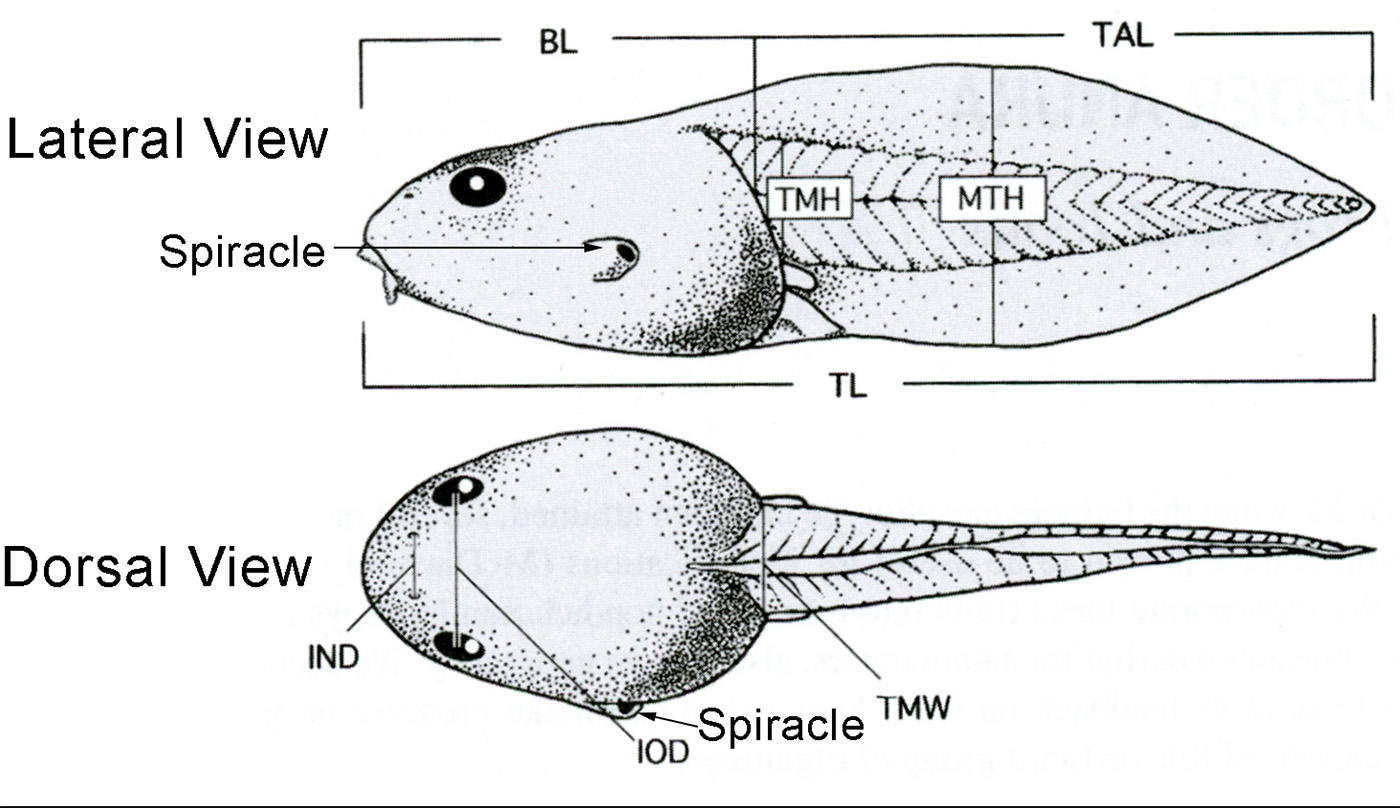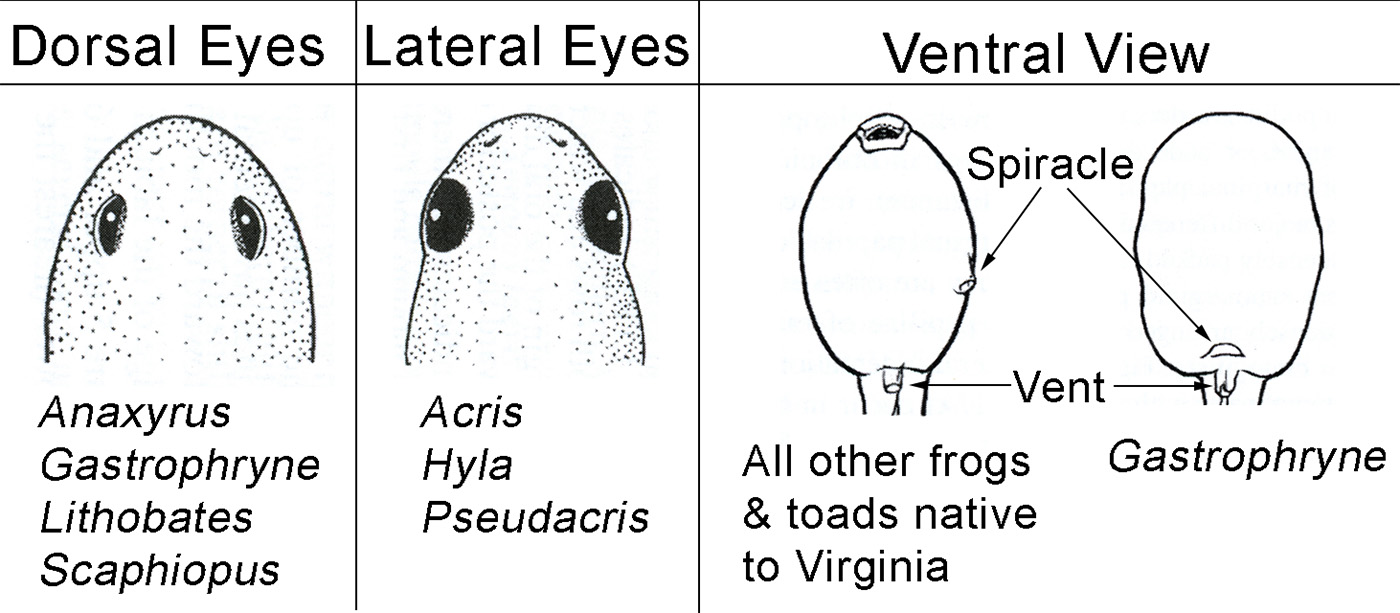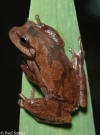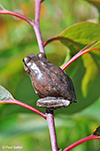Pine Woods Treefrog
Dryophytes femoralis
Common Name: |
Pine Woods Treefrog |
Scientific Name: |
Dryophytes femoralis |
Etymology: |
|
Genus: |
Dryophytes The name "Dryophytes" is derived from the Greek words "dryos," meaning tree, and "phytes," meaning plant, which refers to the arboreal habits of these frogs. |
Species: |
femuralis is Latin meaning "pertaining to the hind leg" Referring to the leg markings found on this species. |
Average Length: |
1 - 1.5 in. (2.5 - 3.8 cm) |
Virginia Record Length: |
|
Record length: |
1.8 in. (4.4 cm) |
Physical Description - This is a slender hylid species reaching lengths of 25 to 38 mm (1-1.5 in). It is typically a reddish brown color with dark dorsal markings though color may range from pale gray to dark brown. A distinguishing characteristic is a group of small orange, yellow or whitish spots on the rear of the thigh. Breeding males have a very distinctive "dot-and-dash" call which has earned it the name of the "morse code" frog.
Historical versus Current Distribution - The historical distribution of Pine Woods Treefrogs (Dryophytes femoralis) is unknown but may have been larger than today due to the presence of isolated disjunct populations in Alabama and Mississippi (Hoffman, 1988). There is a questionable record from southern Maryland. Pine Woods Treefrogs occur from the middle Coastal Plain of Virginia, south through most of Florida, except the Everglades, and west to eastern Louisiana.
Historical versus Current Abundance - Historical abundance is unknown. Pine Woods Treefrogs are locally common in most of their range.
Life History Features - Aspects of the life history of Pine Woods Treefrogs are in Wright (1932), Harper (1932), and Wright and Wright (1949), but a complete modern synthesis is not available.
Breeding - Reproduction is aquatic.
Breeding migrations - Adults migrate from arboreal retreats to breeding sites, but mass migrations have not been reported.
Breeding habitat - Breeding sites include depressional wetlands in pine flatWoods, Carolina bays, vernal pools, ditches and other shallow water-filled depressions, and swamps. Pine Woods Treefrogs are early colonizers and often call from pools in clearcuts and fields.
Calling sites are usually on vegetation in and around breeding sites, as high as several meters above the substrate. Large choruses are heard after heavy rains. Calling periods are early April to October in central Florida (Carr, 1940a; Einem and Ober, 1956); March to mid September in Georgia (Harper, 1932; Brandt, 1953); April–August in Alabama (Mount, 1975); early April to mid August in Louisiana (Dundee and Rossman, 1989); April–August in North Carolina (Brandt, 1936a; personal observations); and May–August in Virginia (Mitchell, 1986). Einem and Ober (1956) noted that males stopped calling when a hurricane passed through Florida in 1953. Egg-laying occurs in May–July in North Carolina (Brandt, 1936a; personal observations) and late May to early August in Virginia (Mitchell, 1986).
Egg deposition sites - Females lay their eggs attached to vegetation or debris no more than 2–3 cm below shallow water (Wright, 1932; Livezey and Wright, 1947; Mount, 1975).
Clutch size - Females lay about 800–2,000 eggs in clusters of about 100 eggs (unpublished data).
Altig & McDiarmid 2015 - Classification and Description:
- Eastern Film
- Arrangement 2 - Eggs oviposited as adherent films,
individual eggs not easily removed from film, top of outer jelly lies at
water surface; jelly diameter not large relative to ovum size. Film diameter
less than 150 mm, ova pale to dark brown.
- Sub-arrangement B - Eggs deposited in ephemeral nonflowing water; Ovum Diameter 0.8-1.2 mm; 2 jelly layers.
- Arrangement 2 - Eggs oviposited as adherent films,
individual eggs not easily removed from film, top of outer jelly lies at
water surface; jelly diameter not large relative to ovum size. Film diameter
less than 150 mm, ova pale to dark brown.
Larvae/Metamorphosis - Larvae may be found from May–September. Wright (1932) reported a larval period of 50–75 d. Metamorphic animals were found early July to mid August in North Carolina (Travis, 1980b) and from 16 June–16 September in Virginia (Mitchell, 1986). SVL at metamorphosis is 11–15 mm (Wright, 1932). Tadpole survivorship in the laboratory was 65–100% (Travis, 1980b).
Tadpoles:

| Lateral View | Dorsal View |
|---|---|
| BL = Body Length | IND = Internarial Distance |
| MTH = Maximum Tail Height | IOD = Interorbital Distance |
| TAL = Tail Length | TMW = Tail Muscle Width |
| TL = Total Length | |
| TMH = Tail Muscle Height |

Juvenile Habitat - Similar to adult habitat.
Adult Habitat - Pine Woods Treefrogs are strongly associated with pine forests, but also may be found in hammocks, swamps, cypress ponds, vernal pools, Carolina bays, mixed hardwood/pine forests, and brackish marshes (Harper, 1932; Duellman and Schwartz, 1958; Neill, 1958a). Pine Woods Treefrogs climb to the tops of longleaf pines (Carr, 1940a), and seek shelter in cabbage palms, bromeliads, and pitcher plants (Smith and List, 1955; Einem and Ober, 1956).
Home Range Size - Unknown.
Territories - Territorial defense is unknown.
Aestivation/Avoiding Dessication - Unknown.
Seasonal Migrations - Pine Woods Treefrogs do not migrate.
Torpor (Hibernation) - Overwintering sites include inside decomposing pine logs and underground about 0.6 m (Carr, 1940a). Pine Woods Treefrogs are active on warm days in winter, emerging from shelters under pine bark and inside the axils of cabbage palms and bromeliads (Einem and Ober, 1956).
Interspecific Associations/Exclusions - Pine Woods Treefrogs are syntopic with Oak Toads (Anaxyrus quercicus), Green Treefrogs (Dryophytes cinerea), Barking Treefrogs (Dryophytes gratiosus), Bird-voiced Treefrogs (Dryophytes avivoca), Little Grass Frogs (Pseudacris ocularis), American Bullfrogs (Lithobates catesbeianus), Cope's Gray Treefrogs (Dryophytes chrysoscelis), Fowler's Toads (Anaxyrus fowleri), Green Frogs (Lithobates clamitans), Southern Cricket Frogs (Acris gryllus), Southern Leopard Frogs (Lithobates sphenocephala), Eastern Spadefoots (Scaphiopus holbrookii), Spring Peepers (Pseudacris crucifer), Squirrel Treefrogs (Dryophytes squirellus), and Eastern Narrow-mouthed Toads (Gastrophryne carolinensis; Harper, 1932; Wright, 1932; Einem and Ober, 1956; personal observations).
Natural and experimental hybrids between Pine Woods Treefrogs and Cope's Gray Treefrogs were reported from Alabama, Mississippi, and Texas by Blair (1958a), Pyburn (1960), Pyburn and Kennedy (1961), Mecham (1965), Fortman and Altig (1973, 1974), and Gerhardt (1974c).
Age/Size at Reproductive Maturity - These life history traits are unknown for any population.
Longevity - Known longevity in captivity is 4 yr, 5 mo (Snider and Bowler, 1992).
Feeding Behavior - Pine Woods Treefrogs prey on grasshoppers, crickets, beetles, caddisflies, ants, wasps, craneflies, moths, and jumping spiders (Carr, 1940a; Duellman and Schwartz, 1958).
Predators - Known predators include Banded Watersnakes (Nerodia fasciata), Black Racers (Coluber constrictor), Eastern Ratsnakes (Pantherophis alleghaniensis), common garter snakes (Thamnophis sirtalis), and ribbon snakes (Thamnophis sauritus; Wright, 1932; E.E. Brown, 1979; Palmer and Braswell, 1995).
Anti-Predator Mechanisms - Adult Pine Woods Treefrogs used the following escape behaviors when placed in enclosures with potential snake predators: flight, remaining motionless, crouching, climbing away, body inflation, walking, and hiding (Marchisin and Anderson, 1978). Tadpoles possess bright coloration, usually red, on the posterior margins of the tail fins and a flagellum, presumably to distract invertebrate predators away from the body (Altig, 1972b; personal observations).
Diseases - None reported.
Parasites - None reported.
Conservation - Pine Woods Treefrogs are locally common in most of their range and are not listed in any state in which they occur. However, several states (Florida, Louisiana, Mississippi, and Virginia) have permit regulations on this and other species regulating the number collected and sold commercially (Levell, 1997).
References
- Altig, Ronald & McDiarmid, Roy W. 2015. Handbook of Larval Amphibians of the United States and Canada. Cornell University Press, Ithaca, NY. 341 pages.
- AmphibiaWeb. 2020. University of California, Berkeley, CA, USA.
- Conant, Roger and, Collins, John T., 2016, Peterson Field Guide: Reptiles and Amphibians, Eastern and Central North America, 494 pgs., Houghton Mifflin Company., New York
- Duellman, William E. and, Trueb, Linda, 1986, Biology of Amphibians, 671 pgs., The Johns Hopkins University Press, Baltimore
- Martof, B.S., Palmer, W.M., Bailey, J.R., Harrison, III J.R., 1980, Amphibians and Reptiles of the Carolinas and Virginia, 264 pgs., UNC Press, Chapel Hill, NC
- Wilson, L.A., 1995, Land manager's guide to the amphibians and reptiles of the South, 360 pp. pgs., The Nature Conservancy, Southeastern Region, Chapel Hill, NC
Photos:
*Click on a thumbnail for a larger version.
Verified County/City Occurrence
Amelia
Brunswick
Caroline
Charles City
Chesterfield
Dinwiddie
Essex
Gloucester
Greensville
Hanover
Henrico
Isle of Wight
King and Queen
King William
Mathews
Middlesex
New Kent
Powhatan
Prince George
Southampton
Surry
Sussex
CITIES
Chesapeake
Suffolk
Virginia Beach
Verified in 22 counties and 3 cities.
U.S. Range







